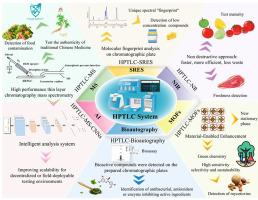Versatile platforms based on HPTLC: Multimodal and green solutions for food and herbal quality assurance
IF 15.4
1区 农林科学
Q1 FOOD SCIENCE & TECHNOLOGY
引用次数: 0
Abstract
Background
Ensuring the authenticity and safety of food and herbal products is becoming increasingly challenging due to globalized supply chains, fraud, and contamination risks. To address these issues, there is an urgent need for advanced screening technologies enabling rapid, reliable, cost-efficient, decentralized, and environmentally sustainable quality management. High-Performance Thin-Layer Chromatography (HPTLC) has been transformed from a simple chromatographic tool to a powerful and versatile analytical platform due to its inherent simplicity and unlimited compatibility with all advanced measurement methods.
Scope and approach
Recent advancements have enhanced HPTLC through integration with high-end techniques, such as Mass Spectrometry (MS), Surface-Enhanced Raman Spectroscopy (SERS), Near-Infrared Spectroscopy (NIR), and Metal-Organic Framework (MOF) modifications, shaping it as a high-resolution, multimodal analytical tool. Furthermore, HPTLC-MS is combined with convolutional neural networks (CNNs) to develop into an intelligent analysis system, achieving automated spot recognition. It has improved the efficiency of data processing, which helps to reduce human errors and enhance reproducibility and the level of automation. Meanwhile, HPTLC is highly consistent with the core Green Analytical Chemistry (GAC) principles and is particularly suitable for sustainable food and herbal safety projects that require high-throughput and decentralized operations. Therefore, multimodal HPTLC enhances the accuracy and automation of analysis while promoting sustainability.
Key findings and conclusions
It is concluded that HPTLC holds promising potential for application in future quality assurance of food and herbal products, as it enables rapid, intelligent, and eco-efficient analysis suitable for both laboratory research and industrial quality control tasks. This review critically examines the latest developments in HPTLC-based multimodal systems, emphasizing the integration of spectral techniques, the use of smart materials, and innovations associated with sustainability.

基于HPTLC的多功能平台:食品和草药质量保证的多模式和绿色解决方案
由于全球化的供应链、欺诈和污染风险,确保食品和草药产品的真实性和安全性正变得越来越具有挑战性。为了解决这些问题,迫切需要先进的筛选技术,以实现快速、可靠、成本效益高、分散和环境可持续的质量管理。高性能薄层色谱(HPTLC)由于其固有的简单性和与所有先进测量方法的无限兼容性,已经从一个简单的色谱工具转变为一个强大而多功能的分析平台。范围和方法最近的进展通过与高端技术的集成,如质谱(MS),表面增强拉曼光谱(SERS),近红外光谱(NIR)和金属有机框架(MOF)修饰,增强了HPTLC,使其成为高分辨率,多模态的分析工具。此外,HPTLC-MS与卷积神经网络(cnn)相结合,发展成为一个智能分析系统,实现自动化斑点识别。它提高了数据处理的效率,有助于减少人为错误,提高再现性和自动化水平。同时,HPTLC高度符合绿色分析化学(GAC)的核心原则,特别适用于需要高通量和分散操作的可持续食品和草药安全项目。因此,多模态HPTLC提高了分析的准确性和自动化,同时促进了可持续性。结论HPTLC在未来的食品和草药产品质量保证中具有广阔的应用前景,因为它可以实现快速、智能和生态高效的分析,适用于实验室研究和工业质量控制任务。本文回顾了基于hptlc的多模态系统的最新发展,强调了光谱技术的集成、智能材料的使用以及与可持续性相关的创新。
本文章由计算机程序翻译,如有差异,请以英文原文为准。
求助全文
约1分钟内获得全文
求助全文
来源期刊

Trends in Food Science & Technology
工程技术-食品科技
CiteScore
32.50
自引率
2.60%
发文量
322
审稿时长
37 days
期刊介绍:
Trends in Food Science & Technology is a prestigious international journal that specializes in peer-reviewed articles covering the latest advancements in technology, food science, and human nutrition. It serves as a bridge between specialized primary journals and general trade magazines, providing readable and scientifically rigorous reviews and commentaries on current research developments and their potential applications in the food industry.
Unlike traditional journals, Trends in Food Science & Technology does not publish original research papers. Instead, it focuses on critical and comprehensive reviews to offer valuable insights for professionals in the field. By bringing together cutting-edge research and industry applications, this journal plays a vital role in disseminating knowledge and facilitating advancements in the food science and technology sector.
 求助内容:
求助内容: 应助结果提醒方式:
应助结果提醒方式:


